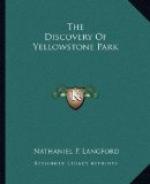Day before yesterday Mr. Gillette and I discussed the question of the probability of a man being able to sustain life in this region, by depending for his subsistence upon whatever roots or berries are to be found here. We have once before to-day referred to the fact that we have seen none of the roots which are to be found in other parts of the Rocky Mountain region, and especially in the elevated valleys. We have not noticed on this trip a single growing plant or specimen of the camas, the cowse, or yamph. If Mr. Everts has followed the stream on which we were camped the day he was lost down into the Snake river valley, he will find an abundance of the camas root, which is most nutritions, and which will sustain his life if he has sufficient knowledge of the root to distinguish the edible from the poisonous plant.
I have been told by James Stuart that in the valley of the Snake river the “camas” and the “cowse” roots are to be found in great abundance, and are much prized as food by the Indians. “Cowse” is a Nez Perce word, the Snake Indians give the name “thoig” to the same root. It grows in great abundance in the country of the Nez Perce Indians, who eat great quantities of it, and these Indians are called by the Snake Indians the “Thoig A-rik-ka,” or “Cowse-eaters.” The camas is both flour and potatoes for several wandering nations, and it is found in the most barren and desolate regions in greatest quantity. The camas is a small round root, not unlike an onion in appearance. It is sweet to the taste, full of gluten, and very satisfying to a hungry man. The Indians have a mode of preparing it which makes it very relishable. In a hole a foot in depth, and six feet in diameter, from which the turf has been carefully removed, they build a fire for the purpose of heating the exposed earth surface, while in another fire they heat at the same time a sufficient number of flat rocks to serve as a cover. After the heating process is completed, the roots are spread over the bottom of the hole, covered with the turf with the grass side down, the heated rocks spread above, and a fire built upon them, and the process of cooking produces about the same change in the camas that is produced in coffee by roasting. It also preserves it in a suitable form for ready use.
The yamph has a longer and smaller bulb than the camas, though not quite as nutritious, and may be eaten raw. Either of these roots contains nutriment sufficient to support life, and often in the experience of the tribes of the mountains winters have been passed with no other food. There is a poisonous camas, which is sometimes mistaken for the genuine root, but which cannot be eaten in large quantities without fatal results. It always grows where the true camas is found, and much care is necessary to avoid mixing the two while gathering the roots in any considerable quantity. So great is the esteem in which the camas is held that many of the important localities of the country in which it is found are named for it.[S]




